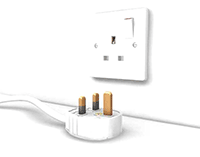Any landlord who lets residential accommodation which includes flats, apartments, houses, holiday homes, bed and breakfast establishments, as a business activity is required by law to ensure the electrical appliances they supply are regularly tested and safe.
This is detailed in the Electrical Equipment (Safety) Regulations Act 1994 which states that any electrical equipment supplied with the accommodation and connected to the mains must be safe.
Insurance companies assume that you meet the above criteria and in the event of a claim arising from fire, injury or death could delay payment, reduce payment or even refuse to settle a claim involving an unsafe appliance which has not been tested.
It is the landlord's responsibility to prove compliance
Examples of the appliances which should be tested include hobs, washing machines, refrigerators, heaters, lamps, microwaves, toasters, hair driers, televisions, kettles, irons and hi-fi equipment. Landlords therefore need to regularly PAT test and maintain all electrical equipment as they may become unsafe over time.
What is PAT Testing?
PAT testing is short for 'Portable Appliance Testing'. With PAT Testing, virtually all items of electrical equipment that have a standard 240 volt three-pin are formally inspected and tested; portable, movable, hand-held, stationary, fixed, built-in, IT equipment and extension leads. Furthermore, the word 'testing' implies that the equipment is only checked over with test instruments. However, this too isn't the case, for the procedure also involves the important use of formal visual inspection
How often should PAT Testing be done?
There are no strict rules or legal requirements, concerning the frequency of combined formal visual inspection and testing ('PAT Testing') of electrical equipment. However, it is generally recommended to have this work carried out on an annual basis.
What do PAT tests involve?
PAT testing consists of 3 separate activities, during which appliances are turned off and disconnected from the supply. The testing includes:-
A visual inspection of the appliance to check for any damage and any poor electrical standards.
A series of tests using technical equipment, to check for electrical faults.
The PAT tester then undertakes a `functional check` to ensure the item is in good working order before applying the “PASSED” label.
The Label states the unique ID no. of the appliance, the date tested and the due date for re-test.
What happens if an item fails?
Most failures are found during the initial visual check (i.e. a cracked plug or an incorrectly rated fuse). These minor repairs will be carried out during the course of the works. However, other failures may not be fixed quickly and may need a qualified electrician to carry out the works, for which you will be informed and if this is the case, we will simply store the items in an appropriate place and make you aware of this immediately.
On Completion
When the test is complete we will then generate a certificate of work done detailing all appliances checked. This will be forwarded to you for your records.

